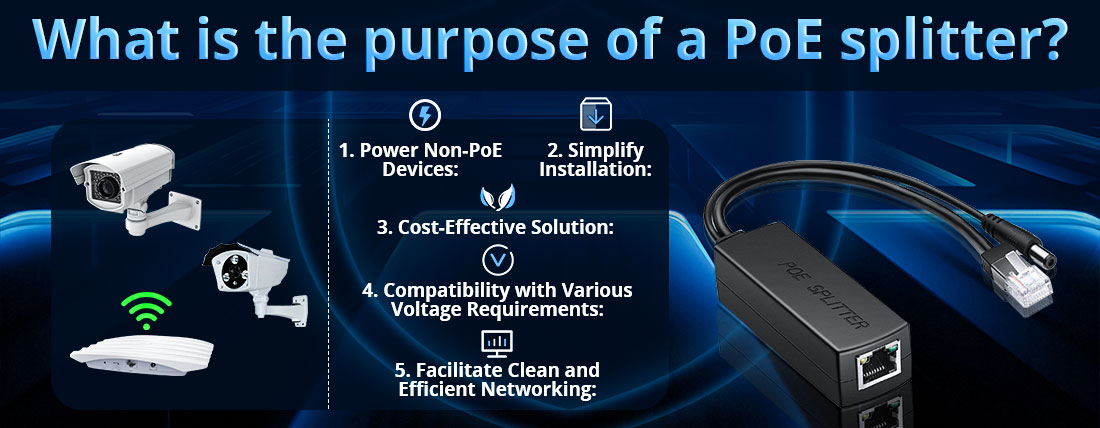
Le but d'un séparateur de puissance sur Ethernet (POE) est de permettre aux appareils qui ne soutiennent pas nativement la puissance sur Ethernet de recevoir à la fois la puissance et les données via un seul câble Ethernet. Essentiellement, il sépare la puissance et les données qui sont combinées dans un câble POE, permettant à des dispositifs non compatibles non POE d'être alimentés et connectés au réseau simultanément.
Dans un système POE, la puissance et les données sont transmises ensemble sur un seul câble Ethernet à partir d'un injecteur PoE ou d'un commutateur compatible POE. Cependant, certains appareils (tels que les caméras de réseau plus anciennes, les points d'accès ou les capteurs) ne sont pas conçus pour gérer PoE. Un séparateur POE aborde cette limitation en divisant la puissance combinée et les signaux de données en sorties distinctes: une pour les données et une pour la puissance. Cela permet à un appareil non POE de bénéficier de la commodité d'un seul câble Ethernet pour la communication et l'alimentation du réseau, même s'il n'a pas de support POE intégré.
Objectifs clés et avantages d'un séparateur POE:
1. Power non-POE Devices:
Le but principal d'un Séparateur de Poe est de fournir une puissance aux appareils qui n'ont pas de fonctionnalité POE intégrée. Par exemple, de nombreux appareils hérités (comme les caméras IP plus anciennes ou les points d'accès sans fil) peuvent toujours nécessiter de l'énergie mais ne peuvent pas accepter directement PoE. Le séparateur extrait la puissance du signal POE entrant et le délivre sous la forme requise (par exemple, 5V, 9V, 12V) pour ces appareils.
2. Simplifier l'installation:
PoE simplifie l'installation du réseau en réduisant le nombre de câbles nécessaires. Cependant, sans séparateur POE, les appareils sans support POE nécessiteraient un câble ou un adaptateur d'alimentation supplémentaire, compliquant l'installation. Un séparateur POE vous permet d'exécuter un seul câble Ethernet du commutateur POE ou de l'injecteur à l'appareil, en minimisant l'encombrement du câble et en réduisant le temps d'installation.
3. Solution rentable:
Les séparateurs POE offrent un moyen rentable d'intégrer des appareils non POE dans une infrastructure de réseau PoE existante. Au lieu de remplacer les appareils plus anciens par des versions compatibles POE, un séparateur POE permet aux entreprises et aux particuliers de conserver le matériel existant tout en tirant parti des avantages de Poe, tels que la gestion centralisée de l'alimentation et le câblage réduit.
4. Compatibilité avec diverses exigences de tension:
Les séparateurs PoE sont disponibles dans divers modèles qui fournissent différentes sorties de tension (telles que 5V, 9V, 12V ou 24 V), vous pouvez donc sélectionner celle qui correspond aux besoins d'alimentation de votre appareil non-POE. Cela fait du séparateur une solution polyvalente pour une large gamme d'équipements.
5. Faciliter un réseau propre et efficace:
Pour les installations qui nécessitent que les appareils soient situés loin des prises de courant ou dans les endroits où l'ajout de prises électriques est difficile ou coûteuse (comme les zones éloignées ou les caméras montées sur le plafond), Poe et Poe Splittants aident à simplifier la distribution d'énergie du réseau en fournissant à la fois des données et Aliver sur un seul câble Ethernet.
Comment fonctionne un séparateur POE:
1. Combinaison de puissance et de données via Ethernet:
Un commutateur ou un injecteur compatible POE envoie à la fois des données et une puissance électrique sur le même câble Ethernet au séparateur.
2. Firsition des signaux:
Le séparateur POE prend le signal combiné et le sépare. Il sortira:
--- Une sortie de données (généralement sur un port Ethernet standard) pour la connexion réseau.
--- Une puissance de sortie (généralement sous la forme d'une tension CC, telle que 5V ou 12V) pour alimenter l'appareil.
3. Connexion aux appareils non-POE:
Le dispositif non POE reçoit la puissance de la sortie de sortie du séparateur et utilise les données de la connexion Ethernet, ce qui lui permet de fonctionner comme un appareil compatible POE.
Exemple de cas d'utilisation:
--- caméras IP: de nombreuses caméras IP plus anciennes peuvent ne pas prendre en charge Poe, mais avec un séparateur POE, vous pouvez alimenter la caméra via le câble POE tout en fournissant une connectivité réseau.
--- Points d'accès sans fil (WAPS): Certains modèles WAP plus anciens peuvent devoir être alimentés séparément, mais un séparateur POE permet de leur alimenter via les mêmes données de transport de câble.
--- Capteurs en réseau ou dispositifs IoT: les périphériques qui nécessitent une surveillance constante mais qui n'ont pas la capacité POE peuvent utiliser un séparateur POE pour recevoir la puissance et les données du même câble Ethernet.
Résumé:
Le but d'un séparateur POE est de combler l'écart entre l'infrastructure réseau propulsée par POE et les appareils non POE, fournissant à la fois la puissance et les données sur un seul câble Ethernet. Il est particulièrement utile pour intégrer l'équipement hérité dans les réseaux PoE modernes, la simplification des processus d'installation et le maintien d'une configuration de réseau propre et efficace avec un câblage minimal.